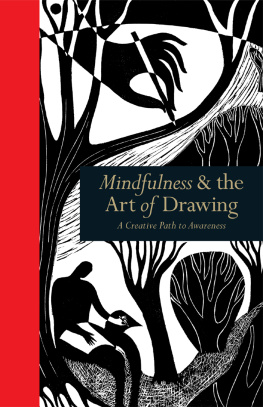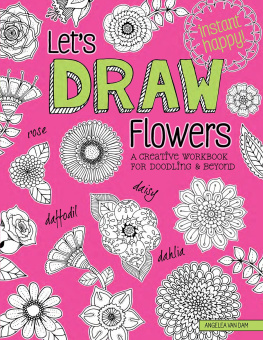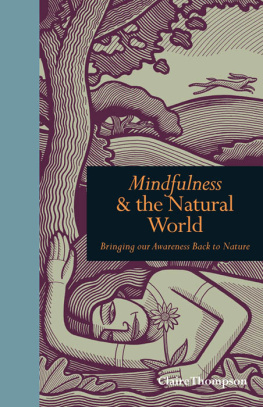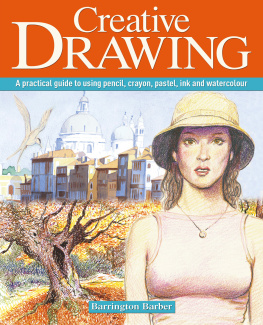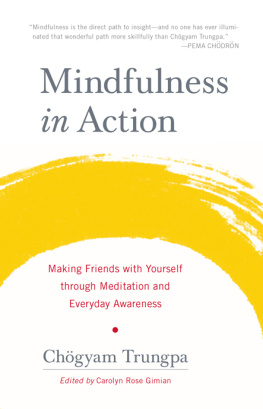
Mindfulness & the Art of Drawing
A Creative Path to Awareness
Wendy Ann Greenhalgh

Leaping Hare Press
Wendy Ann Greenhalgh is a writer, artist and teacher of creative mindfulness. She runs mindfulness workshops, courses and retreats, supporting others as they get creative, explore language, write, draw, take photographs and meditate. She has practised mindfulness in her everyday and creative life for 20 years.
First published in the UK in 2015 by
Leaping Hare Press
210 High Street, Lewes
East Sussex BN7 2NS, UK
www.leapingharepress.co.uk
Text copyright Wendy Ann Greenhalgh 2015
Design and layout copyright The Ivy Press Limited 2015
All rights reserved. No part of this book may be reproduced or transmitted in any form or by any means, electronic or mechanical, including photocopying, recording or by any information storage and retrieval system, without written permission from the copyright holder.
British Library Cataloguing-in-Publication Data
A catalogue record for this book is available from the British Library
Print ISBN: 978-1-78240-283-1
EPUB ISBN: 978-1-78240-340-1
MOBI ISBN: 978-1-78240-341-8
This book was conceived, designed and produced by
Leaping Hare Press
Creative Director P ETER B RIDGEWATER
Publisher S USAN K ELLY
Commissioning Editor M ONICA P ERDONI
Art Director W AYNE B LADES
Editorial Director T OM K ITCH
Senior Project Editor C AROLINE E ARLE
Project Editor J AYNE A NSELL
Editor J ENNI D AVIS
Designer G INNY Z EAL
Illustrator M ELVYN E VANS
Colour origination by Ivy Press Reprographics
Distributed worldwide (except North America) by Thames & Hudson Ltd., 181A High Holborn, London WC1V 7QX, United Kingdom
C ONTENTS


I NTRODUCTION
Everyone can draw. Far from being a rare gift, only possessed by the artists among us, drawing can be as natural and instinctive to us as breathing if we let it. When practised mindfully, drawing has the power to effortlessly lead us into a deeper relationship with ourselves and the world around us, turning a simple act of creativity into play, into a dance of movement, a way of seeing deeply and connecting profoundly with life.

B EGINNING TO D RAW

As children, we draw instinctively, and generally without too much thought, we put crayon to paper and we make marks. We dont generally have a sense of good or bad drawing. We just draw. And that is what this book is about just drawing.
W HEN I WAS SEVEN YEARS OLD, I won the class prize for art. It was nice to go up on stage at the end of term and receive my copy of Wind In The Willows. People clapped. But I wasnt especially hung up on my prize, because I didnt really understand what a prize was. A prize for art of all things was even more of a strange concept, because drawing wasnt anything special, surely? It was just something I did and enjoyed, along with all the other children in my class.
It was only many years later, as a teenager, that drawing really became important to me. Faced with a period of sudden, chronic illness, I rediscovered the magic of paper and pen. Going crazy with boredom and frustration one day, I grabbed a pad and a biro, stuck my foot out, and started drawing it. Toes, ball, instep, arch and ankle gradually took shape on the page. And while my hand sketched, I forgot my worries and became completely absorbed in the creative activity before me. I continued to draw in the months that followed, and once I recovered, I never put the pens and pencils away. That moment in bed, as I drew my own foot, was the moment, though I didnt know it at the time, that drawing became significant for me, the moment I became an artist. Although Ive never won another prize for art, what I discovered as a teenager, and what I find every time I come to a blank page, is that drawing has a profound effect on my state of mind and it is this transformative, mindful aspect of drawing that I value so much and which, as a teacher, Im compelled to share.
Mindfulness & Drawing
So what happens when we draw? And how and why does the simple act of drawing have such an impact on us? For a long time I had no answers, nor did I particularly seek them. I was happy just to be creative and enjoy making marks on pieces of paper; but in my early twenties, after some years drawing, and even briefly working as a freelance illustrator, I discovered mindfulness meditation, and gradually what had been a mystery became clear.
What I discovered was that the practice of mindfulness meditation evoked the same responses from me that drawing did. The state of mind I entered during meditation was qualitatively no different from the one I entered when deeply absorbed in drawing. From this point on, my creative life and my meditative life proceeded hand in hand; I went off to study Fine Art at university, I went on meditation retreats, I practised and I learned. And what I learned was this, and it was surprisingly simple.

I sometimes think there is nothing so delightful as drawing.
V INCENT V AN G OGH (185390)
DUTCH POST-IMPRESSIONIST PAINTER

Finding a Focus
Mindfulness practice and mindfulness meditation, like many other meditative traditions, provide meditators with a focus for their mind. In mindfulness practice, this focus is most often the sensations in the body and the movement of the breath as it flows in and out. In other meditative traditions a mantra might be used, or a candle flame, or an image. What these different focuses all do is give our busy, thinking minds something to rest on, something to dwell in, something to come back to when the rush of thoughts, memories, fantasies, futures, pasts, emotions, attractions, aversions or desires threatens to sweep us away from the here and now.
In mindfulness practice, the focus of the body and the breath is our anchor, securing us so that we arent tumbled around as greatly by the teeming activity of our thinking minds. When we are practising the mindfulness of drawing, it is the movement of the pen across the page, the coordination of eye and hand, and the object we are drawing that become our mindful focus. And having this firm focus is essential, because without it we cannot begin to calm our minds, cannot hope to find space in our heads and in our hearts, or to come into a broader state of awareness, of simply being.
As modern humans, in industrialised, technologised societies, theres no doubt that our minds are conditioned for overactivity. They jump around from one thing to another, constantly stimulated or even overstimulated by a barrage of media, social media, TV , internet, traffic, crowds, work, busy social lives and family lives. The truth is that for most of us, unless we make a special effort, there are very few moments of silence, tranquillity or peace in our days. Its harder than ever for us to find a space to calm and quiet our minds, to simply
Next page
